| Day One Summary | Day Two Summary | Day Three Summary |
|---|
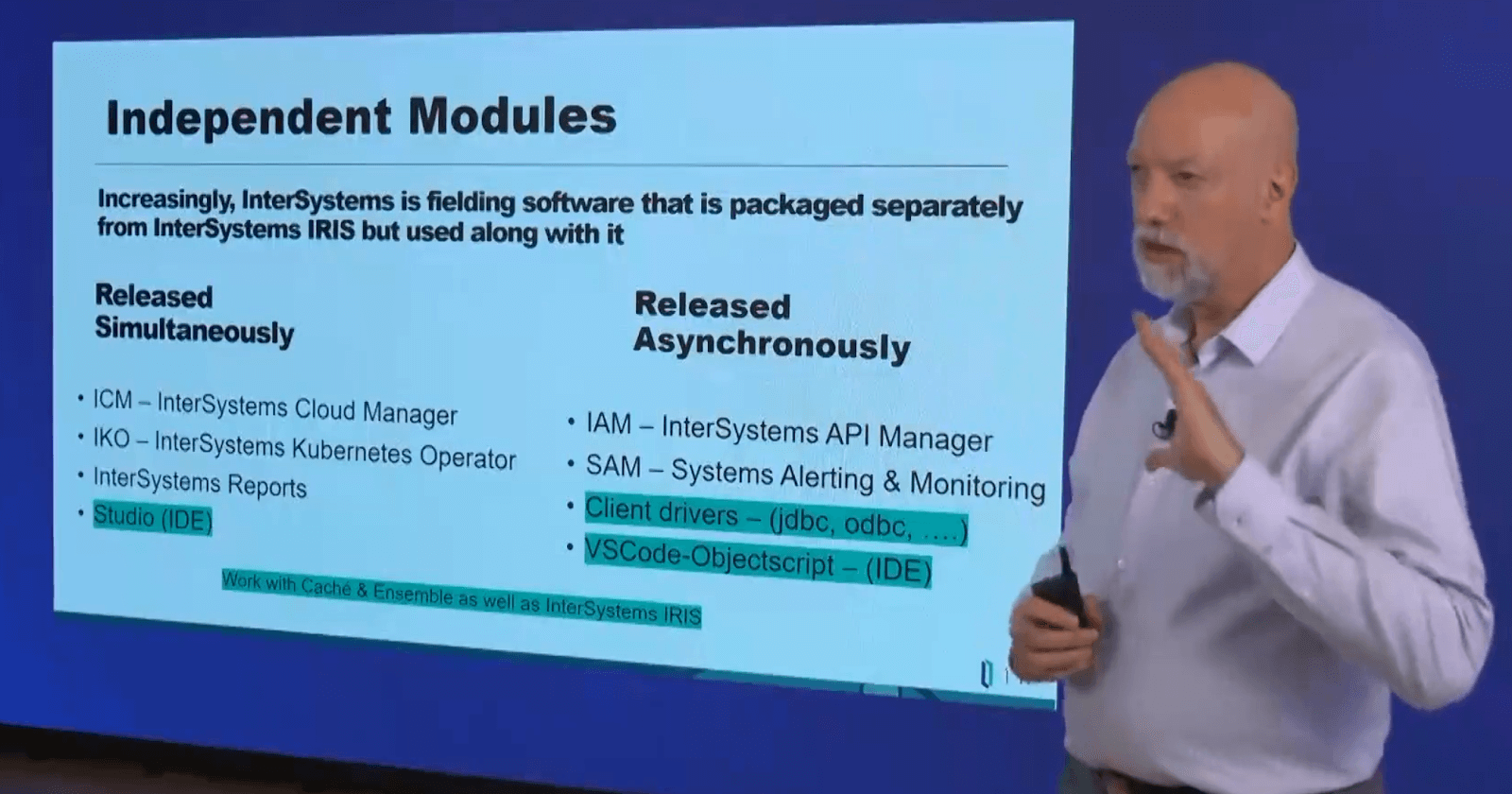
2020 marks the first year ever of InterSystems’ Global Summit going virtual! Join us from October 20th to November 5th as we recap various sessions of this year’s event.
Today is the second day of the Focus Sessions! Our team attended some, and we’ve provided highlights below. Miss today’s presentations? You can still view the recordings. Register for free here.
Visualization Choice: InterSystems IRIS BI, Reports, and Power BI
Summary by: Jen Carter, Executive of Marketing, J2 Interactive

- Date: October 28, 2020
- Presenter: Mark Massias, Senior Sales Engineer, InterSystems
- Overview: InterSystems is expanding upon its analytics and BI capabilities through tighter integrations with other software vendors.
This presentation brought us back to our favorite imaginary supplier of donuts, bagels, and the like: HoleFoods. We enjoyed demos of three examples of analytics and reporting at work in the InterSystems stack.
The first demo was of the InterSystems BI tools. We saw a user on the Analyzer, clicking and dragging cube dimensions to discover which food has been the most heavily discounted and where it is being sold. We then saw a dashboard created within InterSystems BI and looked at some of the visualizations offered.
The second demonstration showed the same cube data in Microsoft PowerBI using InterSystems’ new native adapters, designed for clients who are already using PowerBI for analytics.
The final demonstration was of InterSystems Reporting. This new feature of ISC joins together the report building capabilities of the Logi Reports on the InterSystems platform. The GUI driven interface allows end-users to design, publish, and deliver reports.
HSPI – A look ahead
Summary by: Peter Holman, Principal Consultant, J2 Interactive

- Date: October 28, 2020
- Presenter: James Derrickson, Product Manager – HealthShare Product Management, InterSystems
- Overview: This presentation included a discussion of how machine learning can enhance patient matching to reduce the HSPI manual worklist.
HSPI customers typically have between three and ten FTEs to manually review patient matching. The HSPI team reviewed customers’ worklist manual processing outcomes to develop an automated algorithm to achieve the same result with less manual effort.
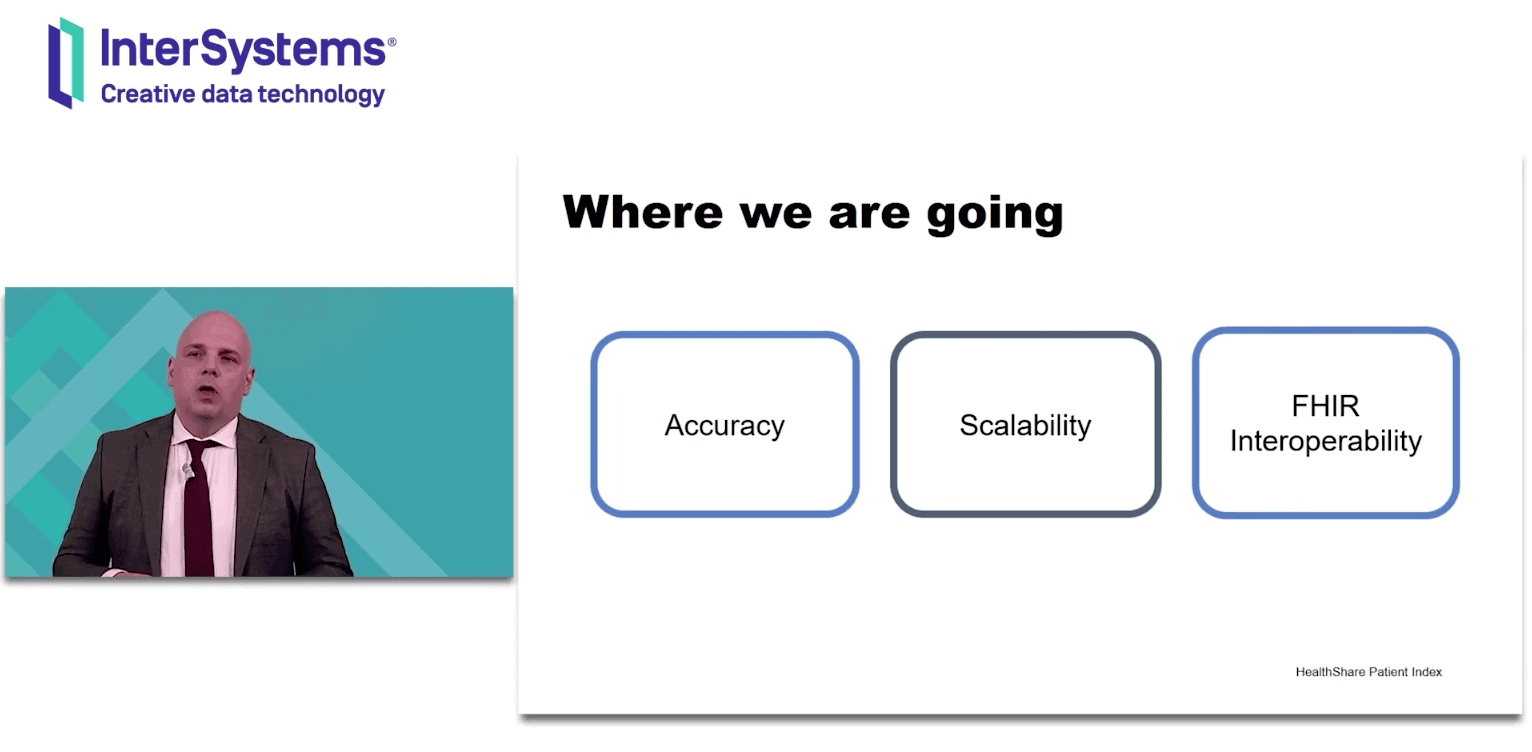
The automated algorithm achieved a 98% accuracy on matching the same patients and a 95% rate on correctly identifying different persons.
It was also mentioned that they are looking at referential patient matching with companies like Lexus/Nexus to assist in patient matching when the data is inconclusive.
Improving Speciality Medication Adherence Using FHIR
Summary by: Ayesha Lefebvre, Senior Consultant, J2 Interactive


- Date: October 28, 2020
- Presenters:
- Matthew Stannard, Life Sciences Advisor, InterSystems
- Matt Smallcomb, Product Director, RxMx
- Overview: The burgeoning market for specialty medications requires the development of medical guides and communication plans, implementation systems, and ETASU. Intersystems has a common FHIR stack across its products that is being leveraged by healthcare players globally. RxMx is a product that was built on IRIS for Health that helps major pharma companies launch and monitor specialty medications.
In 1990, there were just ten specialty medications. In 2015, there were more than 300. There is a heavy cost associated with non-adherence—in the USA, up to 125,000 deaths/year, and 10% of all hospitalizations are due to drug misuse—is costing healthcare systems up to $1B/year.
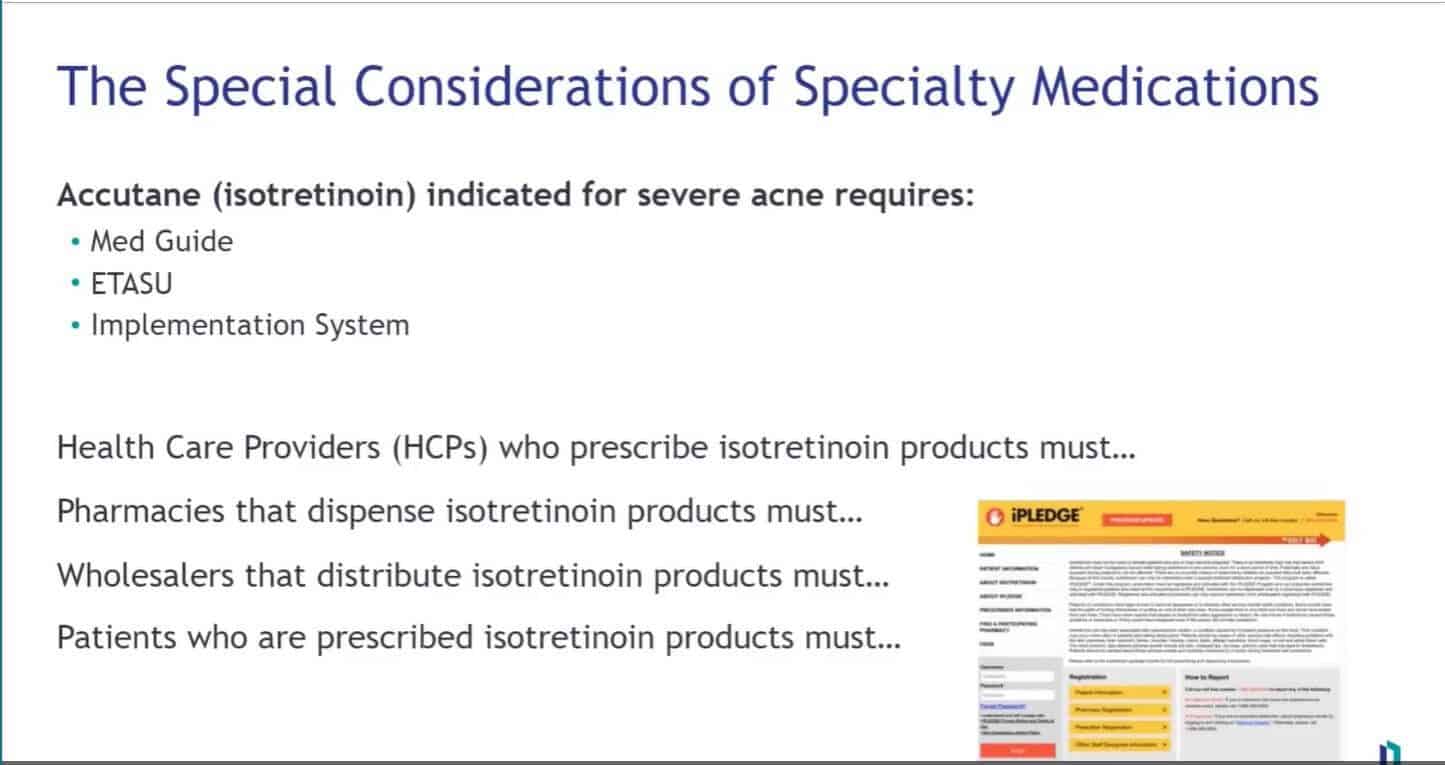 To improve compliance for specialty medication (which can apply to ALL medications), we can leverage technology to develop digital adherence monitoring, intervention, and analytics to safely deliver medications to patients while minimizing patient and care providers’ burden. FHIR is mandated to create an open API that enables greater interoperability that can be used to provide the data exchange between pharmacy, doctors, and patients.
To improve compliance for specialty medication (which can apply to ALL medications), we can leverage technology to develop digital adherence monitoring, intervention, and analytics to safely deliver medications to patients while minimizing patient and care providers’ burden. FHIR is mandated to create an open API that enables greater interoperability that can be used to provide the data exchange between pharmacy, doctors, and patients.
ISC is actively engaged in developing the FHIR standard and has a common FHIR stack across its products (HealthShare, IRIS for Health, and TrakCare), making developing adherence and compliance solutions for medications easier.
Part II of the session: RxMx
Built on IRIS for Health, RxMx has built a solution that helps pharmaceutical companies launch and support specialty medications. RxMx provides “seamless integration” with 3rd party vendors. Doctors and care provider team members are notified in real-time if lab results are outside predetermined ranges.
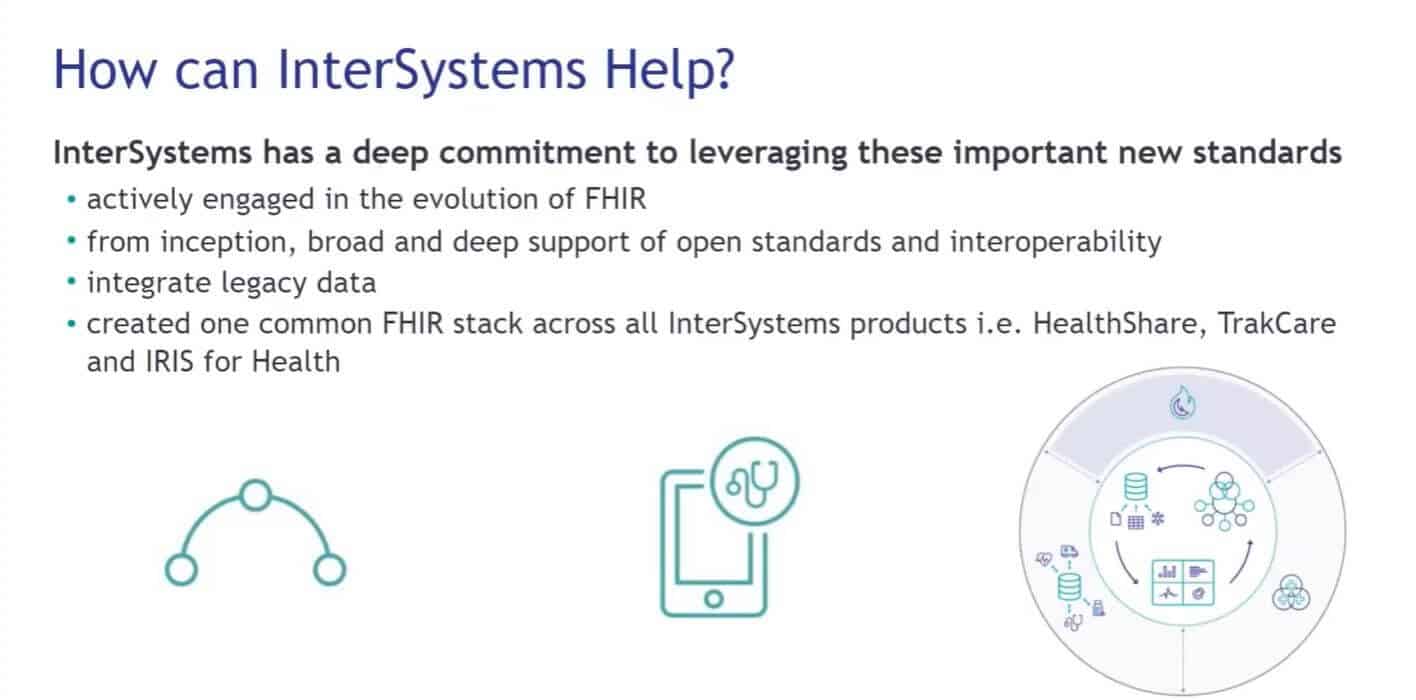
Data from labs and 3rd party vendors enter the RxMx system, which processes the information and feeds it to configured applications and portals designed for specific drug or treatment protocols.
Patients are added directly through the portal, and doctors (or other registered users) can be alerted via email or text. The RxMx system is designed as a low-input/high-output system so that users enter the minimum amount of data to receive targeted notifications and robust reports. User preferences are configurable (values, frequency of alerts, and device choice).
Coming Soon:
- Integration with smart devices for patient adherence
- Integration with medical devices for remote monitoring
- Communication monitoring by AI and machine learning to trigger notifications
- Integration of patient-reported outcomes into notification algorithms
The presentation closed with the announcement of a new product called “Certify COVID Clear,” which was developed this year to manage COVID-19 test data and monitoring to help companies safely re-open for business.
Employers can use the platform to monitor employee test results while employees have a portal to take daily symptom surveys.
Stay in Sync with Change Data Capture
Summary by: Chad Cassens, Senior Consultant, J2 Interactive

- Date: October 28, 2020
- Presenter: Harry Tong, Senior Solutions Architect, InterSystems
- Overview: This presentation included a discussion on Change Data Capture.
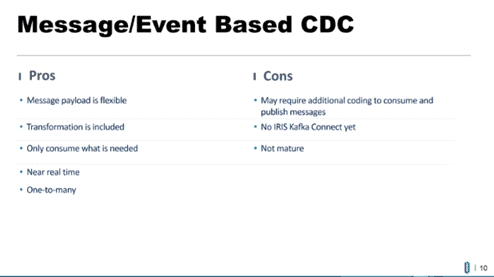 Change Data Capture (CDC) refers to the process of manipulating data in one environment or application and transferring that data to another. This session focused on three ways IRIS can work with data sources: SQL-based CDC, Message/Event-based CDC, and Batch-oriented CDC. (JC Note: I added two hyphens SQL-based and Batch-oriented). IRIS can be a transactional and analytical data source while maintaining transparent data synchronization inside the platform.
Change Data Capture (CDC) refers to the process of manipulating data in one environment or application and transferring that data to another. This session focused on three ways IRIS can work with data sources: SQL-based CDC, Message/Event-based CDC, and Batch-oriented CDC. (JC Note: I added two hyphens SQL-based and Batch-oriented). IRIS can be a transactional and analytical data source while maintaining transparent data synchronization inside the platform.
SQL CDC is easy to use and maintain and is near-real-time. Message/Event-Based CSC is a more modern approach to CDC with event-based infrastructure that is also near real-time. In addition, it has the ability to transform data as needed en route. Batch CDC is a well-established tool with transformation abilities; however, it is not real-time.
Coordinating, and Managing Care in a Fragmented Healthcare System: Introducing HealthShare Care Community (Parts 1 and 2)
Summary by: Nathan Elliott, Senior Consultant, J2 Interactive

- Date: October 28, 2020
- Presenter: Jeremy Davis, Product Manager, InterSystems
- Overview: Jeremy Davis, Product Manager at InterSystems, presented the rationale for developing and value proposition for implementing InterSystems’ Care Community for care coordination within and between community organizations.
Care coordination often requires active participation, monitoring, and effective hand-offs and communication between care team members. In some cases, care coordination professionals are employed outside of a customer’s organization. Care Community provides a centralized platform to encourage a collaborative culture between care team members where a patient’s care plan can be authored, updated, monitored, shared, and made available to the patient. Care Community is built on InterSystems’ Unified Care Record, so data captured in a patient’s care plan is stored as SDA and can be made available as a document through Clinical Viewer.
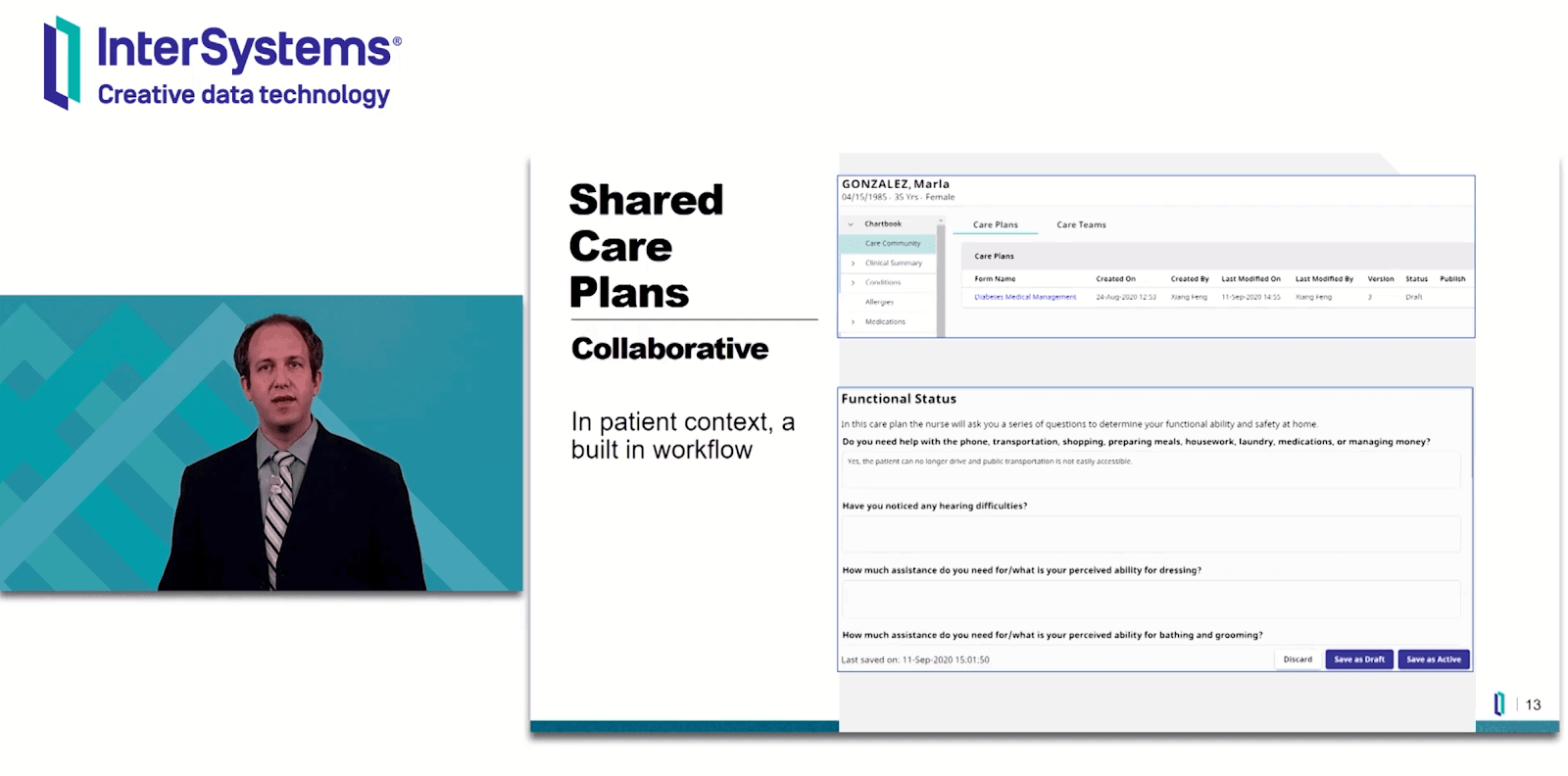 Customers currently on version 2020.2 and in English-speaking geographies can begin taking advantage of Care Community’s flexible, template-driven coordination and communications tools. Near-term enhancements that customers should look for include more robust notifications to care team members that are assigned to a patient care plan. As changes are made to the plan, conditional or “branching” questions are available to care plan authors to drill into specific areas of inquiry with more detail. Enhancements also include the addition of tasks to track follow-up responsibilities.
Customers currently on version 2020.2 and in English-speaking geographies can begin taking advantage of Care Community’s flexible, template-driven coordination and communications tools. Near-term enhancements that customers should look for include more robust notifications to care team members that are assigned to a patient care plan. As changes are made to the plan, conditional or “branching” questions are available to care plan authors to drill into specific areas of inquiry with more detail. Enhancements also include the addition of tasks to track follow-up responsibilities.
Current and prospective customers interested in this capability can contact Jeremy directly at Jeremy.Davis@InterSystems.com or find him at LinkedIn.
NORA, A Virtual Assistant for Clinicians: Innovation with Microsoft Teams & Northwell Health
Summary by: Corky Tate, Director of Professional Services, J2 Interactive

- Date: October 28, 2020
- Presenters:
- Kim Humby, Director of Emerging Technology & Innovation, Northwell Health
- Daniel Baker MD, Medical Director, Lenox Hill Hospital
- Overview: This presentation included a demonstration of an innovative product by Northwell Health, NORA, which Northwell Health intends to take as a product into the healthcare marketplace.
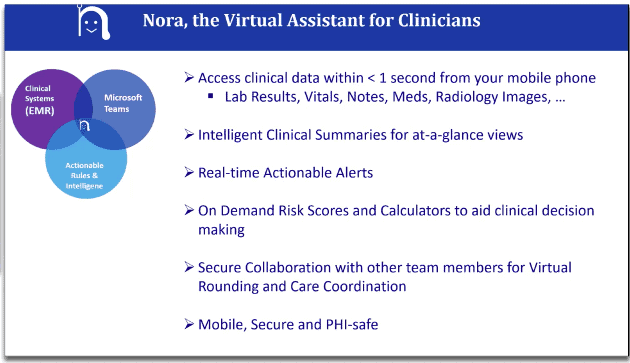 Northwell Health, one of the largest healthcare systems in the United States, created NORA as a result of a Northwell Innovation Challenge in 2018. NORA, a virtual system for clinicians, is embedded into Microsoft Teams. This system provides quick access to clinical data, intelligent summaries, and real-time alerts on mobile platforms. Clinicians can interact with NORA with either key entry or voice.
Northwell Health, one of the largest healthcare systems in the United States, created NORA as a result of a Northwell Innovation Challenge in 2018. NORA, a virtual system for clinicians, is embedded into Microsoft Teams. This system provides quick access to clinical data, intelligent summaries, and real-time alerts on mobile platforms. Clinicians can interact with NORA with either key entry or voice.
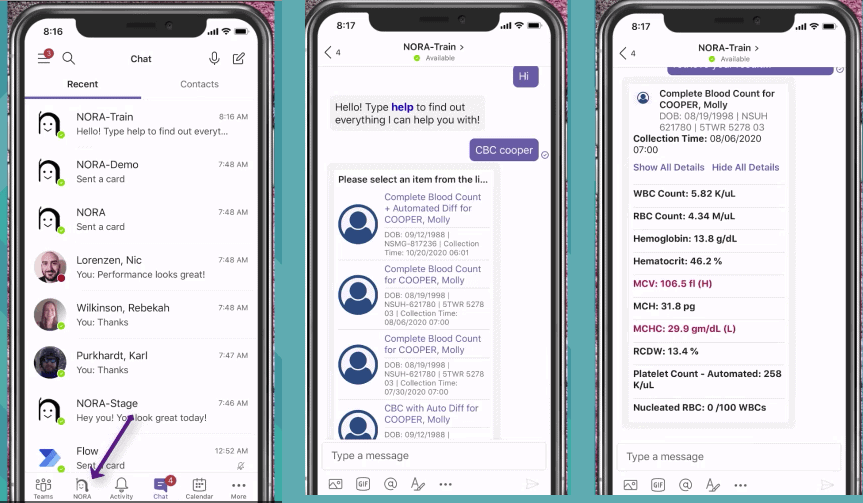
Northwell Health created smart summaries to help group commonly used queries with a single command. Clinicians can also set up alerts for specific patients and conditions and for particular timeframes.
Dr. Baker, Medical Director from Lenox Hill Hospital, provided a clinical perspective from real use cases. He talked about how NORA became useful in determining individual patient evaluations for the use Remdesivir treatments. He discussed the intuitive nature of the product and quick adoption when introduced to clinical personnel. Dr. Baker felt that the summary cards provided by NORA were particularly powerful clinical tools.
Kim Humby, Director of Emerging Technology & Innovation at Northwell, returned at the end of the presentation to talk about NORA’s Population Alerts and Care Team Collaboration and demonstrated a “Set COVID alert”:
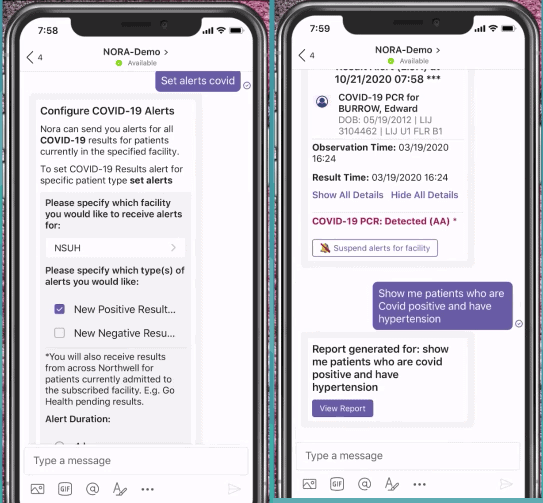
She then walked the audience through a number of other examples before concluding with a discussion of the overall Northwell environment.
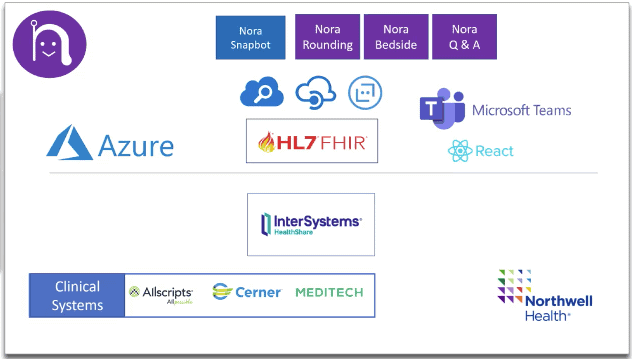
J2 participated in helping to bring this from concept to product too! J2 Senior Consultant, Karl Purkhardt, participated in the innovation development team from the beginning, working on React components and helping to fine-tune it. Additionally, Senior Consultant Jason Anderson worked with Purkhardt to integrate “NORA Snapbot” into the HealthShare Clinical Viewer.
Cloud Storage Strategies
Summary by: Chad Cassens, Senior Consultant, J2 Interactive

- Date: October 28, 2020
- Presenter: Mark Bolinsky, Principal Technology Architect, InterSystems
- Overview: Mark Bolinsky gave a presentation on storage strategies when doing a cloud implementation of IRIS.
When designing a cloud implementation of IRIS, special consideration for the environment’s storage needs must be considered. There are often different types of storage that will be available through cloud hosting. Your IRIS use cases should help guide you to the best performance-to-cost ratio.
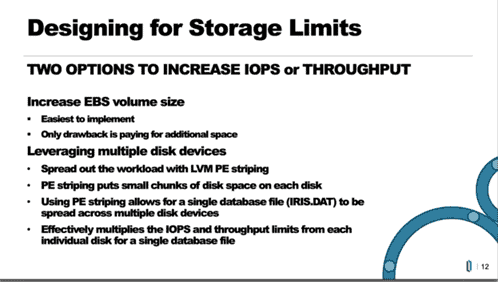 Cloud storage has imposed limits based on volume type and size. High-performance environments that will be utilizing increased IOPS may have options to maximize performance, such as increasing the EBS volume size or leveraging multiple disk devices utilizing LVM PE striping. Increasing the EBS volume size is an easy solution but would require additional cost. LVM PE (Physical Extent) allows for an increased number of disk drives to participate in database writes and therefore spreads I/O across more resources.
Cloud storage has imposed limits based on volume type and size. High-performance environments that will be utilizing increased IOPS may have options to maximize performance, such as increasing the EBS volume size or leveraging multiple disk devices utilizing LVM PE striping. Increasing the EBS volume size is an easy solution but would require additional cost. LVM PE (Physical Extent) allows for an increased number of disk drives to participate in database writes and therefore spreads I/O across more resources.
Cloud Backup Strategies
Summary by: Chad Cassens, Senior Consultant, J2 Interactive

- Date: October 28, 2020
- Presenter: Mark Bolinsky, Principal Technology Architect, InterSystems
- Overview: Mark Bolinsky gave a presentation on backup strategies for IRIS hosted in the cloud.
Backups for IRIS hosted in the cloud are not all that different from backups of environments outside of the cloud. The three main strategies used for backups are Online Backups, Disk Snapshots, and LVM Snapshots.
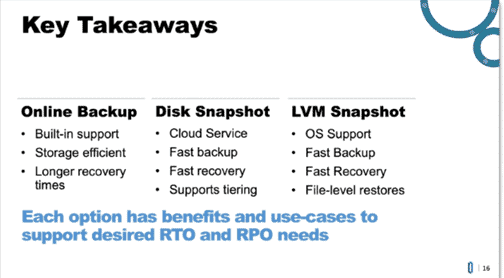 Online backups utilize InterSystems technology to backup necessary database blocks to a file location. This utilization allows for different storage types (for example, cheaper cloud file storage) to be used when saving the Online Backup output file. Disk and LVM snapshots will both need to employ Intersystems APIs to appropriately freeze and thaw the application during the snapshot. However, both allow for faster backup and recovery options versus Online Backups.
Online backups utilize InterSystems technology to backup necessary database blocks to a file location. This utilization allows for different storage types (for example, cheaper cloud file storage) to be used when saving the Online Backup output file. Disk and LVM snapshots will both need to employ Intersystems APIs to appropriately freeze and thaw the application during the snapshot. However, both allow for faster backup and recovery options versus Online Backups.
RTO and RPO considerations need to be taken into account when considering which backup strategy to use at your organization.
InterSystems Product Lifecycle
Summary by: Nathan Elliott, Senior Consultant, J2 Interactive

- Date: October 28, 2020
- Presenter: Jeff Fried, Director of Product Management, InterSystems
- Overview: Jeff Fried, Director of Product Management at InterSystems, shared InterSystems’ approach to releasing upgrades and new products to support customers’ needs to stay current with the latest enhancements while ensuring rock-solid stability.
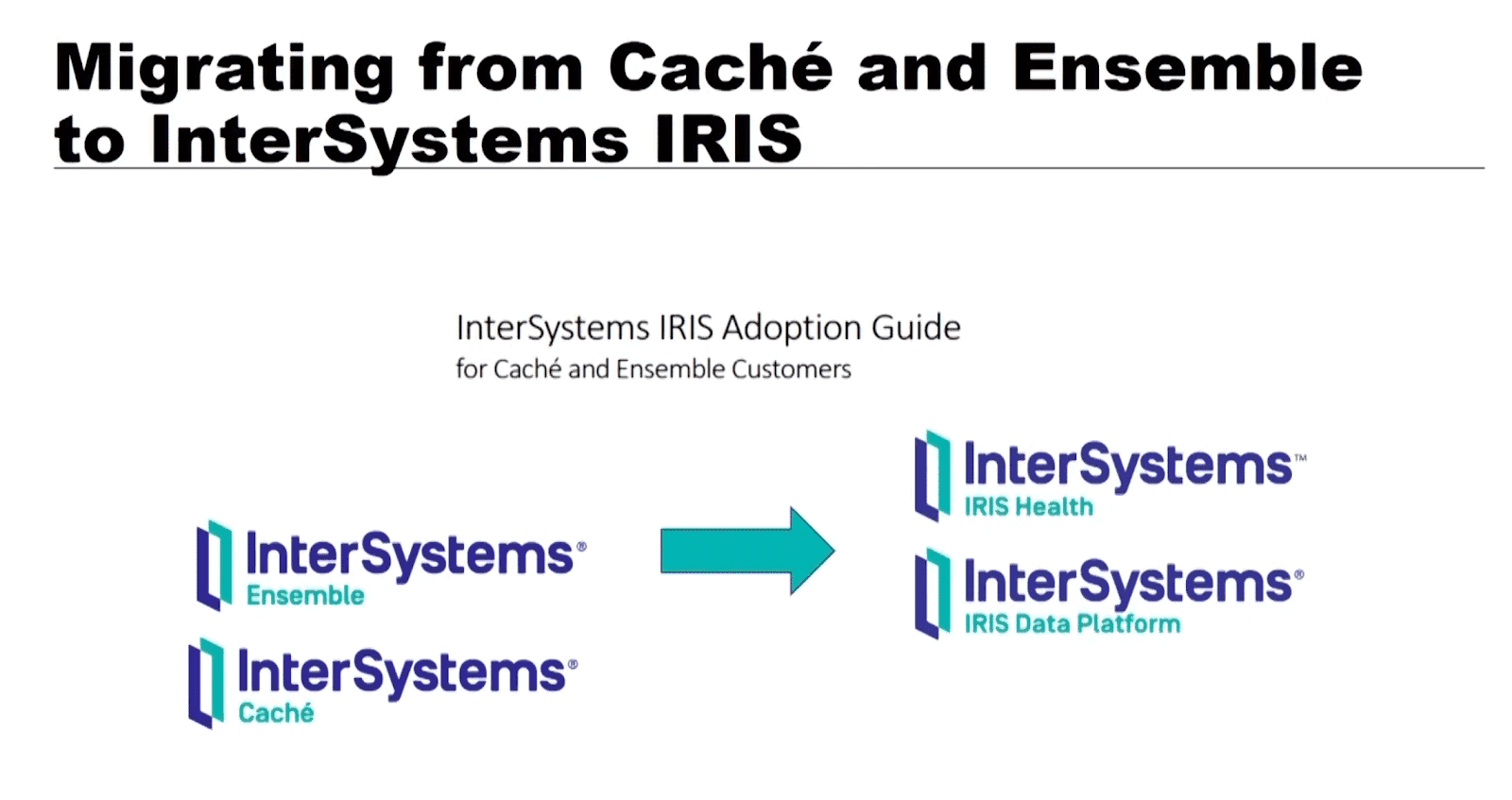
Jeff Fried explained that while InterSystems’ customers are increasingly migrating to IRIS as the next-generation database and solutions platform, InterSystems will continue to support Caché and Ensemble indefinitely for those customers who feel that all of their needs are met with that technology.
InterSystems has been working to find a balance between releasing rock-solid code and the need for customers to continue to implement new features and tools to quickly respond to an ever-changing environment. Part of the approach is to have IRIS on dual release streams, where Extended Maintenance (EM) Kits and Continuous Delivery (CD) Containers are made available at regular intervals more often than the standard annual major releases.
For customers interested in IRIS, Fried directed viewers to the WRC. Detailed documentation currently exists there for adoption or migration planning. Viewers can contact their account teams for more information.
System Alerting & Monitoring
Summary by: Greg King, Systems Architect, J2 Interactive

- Date: October 28, 2020
- Presenter: Murray Oldfield, Technology Architect, InterSystems
- Overview: The presentation gave an overview of the SAM (System Alerting and Monitoring) bundle features and its ease of use. Through a couple of demos, the presenter showed a container-based install and a demonstration of SAM in use.
By beginning the presentation with an overview of the classic nature of IRIS monitoring and alerting, the groundwork was laid to introduce SAM, an easily installed, easily configured one-stop for monitoring and alerting on all your IRIS installations.
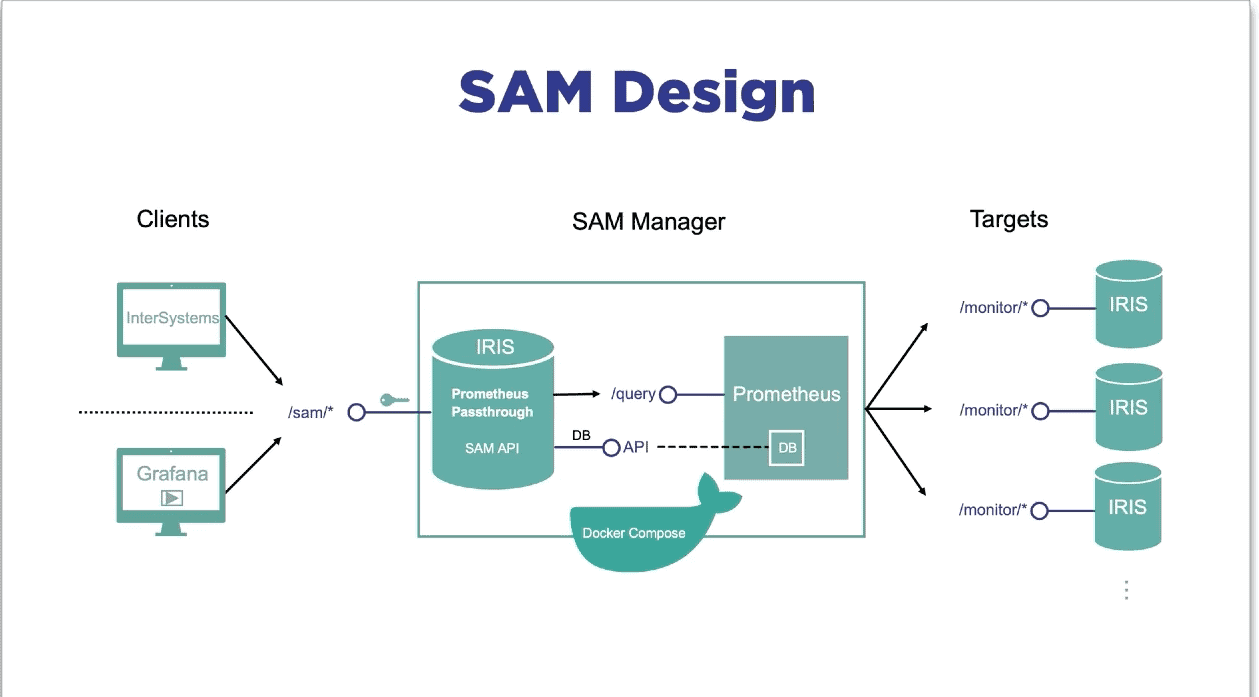 Highlighting the increased move into incorporating open source directly into IRIS products, the presentation highlighted how Prometheus (open source monitoring tool kit) has been tightly coupled to IRIS. SAM includes Prometheus and an IRIS database, thus leveraging IRIS’s long-term storage and power for people’s gathered data. Additionally, SAM contains the open source Grafana package to use as a graphing and dashboard creation tool—bringing the data to life, in a manner of speaking.
Highlighting the increased move into incorporating open source directly into IRIS products, the presentation highlighted how Prometheus (open source monitoring tool kit) has been tightly coupled to IRIS. SAM includes Prometheus and an IRIS database, thus leveraging IRIS’s long-term storage and power for people’s gathered data. Additionally, SAM contains the open source Grafana package to use as a graphing and dashboard creation tool—bringing the data to life, in a manner of speaking.
The presenter made a key point that the monitored metrics in any IRIS database are available via a documented API. You can ingest those metrics with other tools besides Prometheus, for example.
The demonstrations were easy to follow and were a real selling point. They made clear how easy it is to get SAM and long-term data monitoring up and running. The presentation also touched on using Prometheus’s ability to gather system-level statistics through node exporter and interpreting those alongside your IRIS metrics. Finally, the demo highlighted that data gathering could be extended to the application level, allowing for an even more robust correlation and insight into a systems’ workload.
SAM is documented with IRIS; search to find the System Alerting and Monitoring Guide.
The Promise of FHIR
Summary by: Ayesha Lefebvre, Senior Consultant, J2 Interactive

- Date: October 28, 2020
- Presenter: Matthew Spielman, Product Manager, InterSystems
- Overview: This presentation contained ISC Product Managers’ thoughts on FHIR and their predictions (over the next 18-24 months) on the FHIR standard, as well as what we can expect from InterSystems.
The presentation began with a retrospective of FHIR (adoption and development) at InterSystems.
In 2013, there were HIE and web services offerings in ISC products. FHIR was just an idea, not well known.
2014, ISC was discussing HIE, CDA, and Meaningful Use (MU) Stage 1 & Stage 2. In early 2014, Mitre published the JASON report, and the presenter Matthew Spielman had a conversation with Graham Grieve (creator of FHIR). As a result, ISC started looking into FHIR and IHE profiles as concepts and a possible way to introduce these into the existing product stack.
In 2015 there was still no official FHIR support in ISC products. However, ISC was looking at reconciling the SDA data model with the FHIR data model without breaking HealthShare. Clinical data exchange was happening with CDA, and HSIE was document-centric, which was not compatible with FHIR based data exchange. Spielman began a project called Vulcan to investigate how to incorporate FHIR into existing product tech stacks.
In 2016, ISC began developing FHIR capabilities. However, their clients and customers were still not aware of FHIR as a standard nor expressed a need for FHIR solutions to meet their business demands. In addition, this year saw Vulcan begin iterations of design, POCs, and demos.
In 2017, ISC released the first version of the FHIR Gateway (v1) in Information Exchange 15.03, HealthConnect 15.03 with DSTU2. This release had a FHIR messaging model with FHIR: SDA transformations and some IHE FHIR Profile support, as well as SMART on FHIR support in HealthShare. The main issue at the time was how to introduce FHIR support without breaking existing HealthShare architecture (which was a document-centric exchange model) while also providing a good application experience for their users (in terms of performance, consuming data out of HealthShare).
At InterSystems Global Summit in 2018, ISC introduced the Operational Data Store (ODS). HealthShare Information Exchange 2018.1 included STU3 support and a new transformation tool:
- ODS: Centralized cache of clinical data within Information Exchange
- FHIR Gateway v2: A way to get data out of ODS with a FHIR API.
In 2019, ISC continued its iterative improvement process on ODS with the release of UCR 2019.1, which included:
- IRIS for Health with FHIR repository, facilitation of custom SDA to custom FHIR extension
- New tools to manage and transform SDA: FHIR with improved efficiency
- Faster indexing and searching of FHIR resources in the repository. Lightweight FHIR objects for each FHIR resource instead of classes
- Improved endpoint configuration
- ODS performance improvements
- FHIR extension mapping improvements
- Consumption of machine-readable representations of FHIR resources into computable FHIR resources directly
2019 also saw ISC customers asking for more FHIR support for the first time, as it was now becoming essential for their businesses.
In 2020, ISC released UCR 2020.1 with improvements for IRISFor Health:
- UCR:
- Faster ODS
- Faster FHIR
- Better GUI (less terminal work)
- IRIS for Health:
- New FHIR stack with FHIR R4
- Regional Profile support
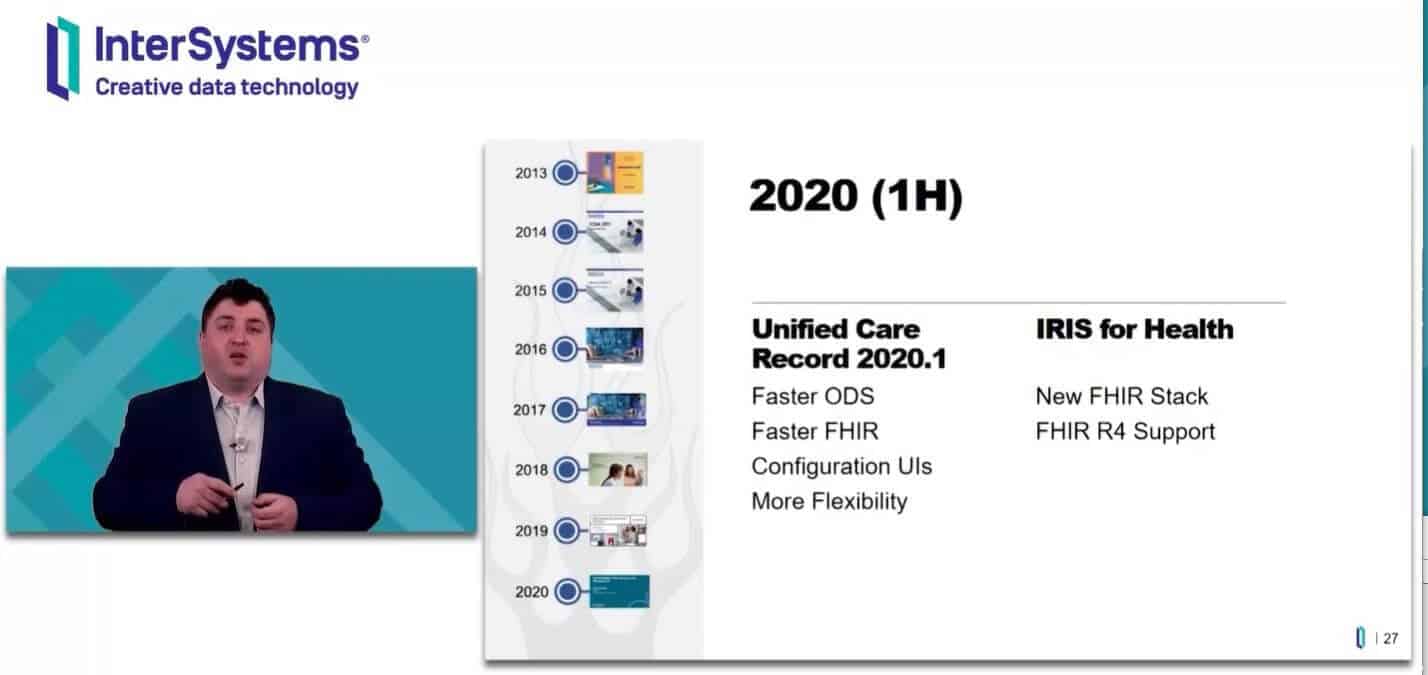 Between 2013 – 2020, the market has evolved globally, from FHIR being a novel idea to a required implementation for healthcare providers and systems. This requirement means that customers are driving changes, pushing for new and better FHIR features and tools (in the US, to meet CMS/ONC requirements).
Between 2013 – 2020, the market has evolved globally, from FHIR being a novel idea to a required implementation for healthcare providers and systems. This requirement means that customers are driving changes, pushing for new and better FHIR features and tools (in the US, to meet CMS/ONC requirements).
An important aspect of FHIR in the near future is the implication it has for replacing existing infrastructure, creating better data transfer and semantic support improvements, and how its compatibility of data access across multiple systems will result in better healthcare IT solutions.
Once this improved infrastructure is in place, there will be improved CDS and rules-based engines that will use FHIR against multiple endpoints where that rule evaluation is present. This use of FHIR is something that was not possible or done efficiently enough in past products at ISC. As FHRI adoption grows, there will be more use cases to implement as well.
As for the next 18-24 months, ISC plans to:
- Create more support for FHIR R5
- Conduct profile improvements
- Implement real-time validation of FHIR resources
Their plan is to leverage existing tooling and investment in FHIR to implement R5 very soon, “within weeks.”
| Day One Summary | Day Two Summary | Day Three Summary |
|---|
![]()
Thank you for joining us for today’s recap. J2 has been a trusted InterSystems Implementation Partner since 2004. Learn more about us and our involvement in InterSystems Virtual Summit 2020.
J2 Interactive is an award-winning software development and IT consulting firm with projects ranging from technology strategy and best-practices consulting to systems integration, application development, health information exchange, and business intelligence.
J2 is a recognized leader in interoperability solutions for customers of all sizes. Drop us a line to find out why.



